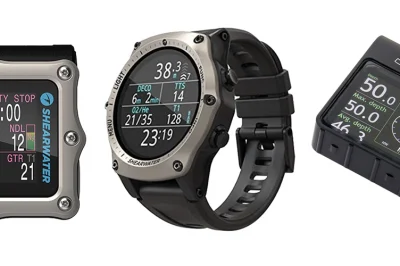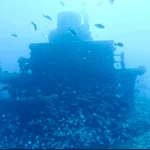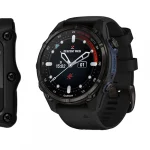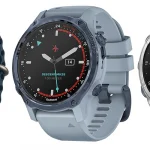Understanding the Urgency: Why 17 Seconds Matter

Table of Contents
- Understanding the Urgency: Why 17 Seconds Matter
- Mastering Emergency Ascents in Strong Currents
- Deconstructing Ascent Myths: What You Need to Forget
- Mistakes that Turn Emergencies into Disasters
- Future-Proofing Your Dives: Technological Advances in Diving Computers
- The Role of Diving Computers in Real-Time Ascent Decisions
- Case for Comparison: Analysing Top Diving Computers
- Diving Like a Pro: Enhancing Skills for Safe Ascents
Introduction
Emergency ascents are crucial maneuvers for divers, especially in the dynamic conditions of Florida’s dive sites. This blog post explores the significance of prompt emergency ascent calculations, emphasising how diving computers can aid in making informed decisions and enhancing diver safety.
Understanding the Urgency: Why 17 Seconds Matter
Mastering Emergency Ascents in Strong Currents
Diving in Florida’s current-rich waters requires a solid plan for emergency ascents. The unpredictable nature of strong currents necessitates understanding specific techniques and preparation strategies. Here’s a step-by-step guide to executing a controlled emergency ascent.
Preparation & Pre-Dive Checks
- Assess Currents: Observe the water movement before diving—watch indicators like kelp swaying, fish patterns, or coral behaviours to gauge current strength.
- Fitness and Mental Calm: Ensure physical fitness and maintain a calm mindset to avoid stress-related mistakes when diving in strong currents.
- Plan Exit Strategies: Outline specific pickup points with your team to avoid confusion during an emergency, especially for drift dives.
Emergency Ascent Techniques
1. Controlled Ascent
- Stay Calm: Avoid panic by adjusting your position to minimise current impact.
- Mark Your Position: Deploy a Surface Marker Buoy (SMB) during safety stops to signal your location. If separated, perform a free ascent while keeping the SMB in view.
- Emergency Swimming Ascent: If you need to ascend:
- Keep your regulator in your mouth and exhale slowly, akin to making an “ahhh” sound.
- Ascend at a maximum rate of 9 metres per minute to avoid barotrauma.
2. Tools & Safety Gear
- Surface Signalling: Inflate your buoyancy control (BC) device and utilise an SMB. If that fails, use bubbles from your octopus regulator to signal for help.
- Current Management: If pulled upward, grab onto a stable substrate but avoid damaging coral or contacting harmful marine life.
- Backup Options: Consider using equipment like lift bags or reef hooks to stabilise yourself—a debated but useful tactic in certain circumstances.
Post-Ascent Procedures
- Stay Visible: Remain positively buoyant and use signalling devices such as mirrors or whistles to alert your boat crew or nearby divers.
- Reconnect with Your Team: Follow safety protocols for reboarding, ensuring you avoid hazards like propellers during entry and exit.
- Surface Awareness: Note your boat’s name and signal to nearby vessels if isolated.
Florida-Specific Considerations
- Upwellings and Downwellings: Be vigilant in areas prone to rapid current changes; employ your SMB if needed during sudden ascents.
- Team Coordination: Discuss contingencies for drift dives ahead of time, ensuring all members understand pickup protocols.
Regular practice of controlled ascents in shallow waters can enhance your comfort and skills, preparing you for the unpredictable dynamics of Florida diving.
Mastering Emergency Ascents in Strong Currents
Common Misconceptions About Emergency Ascents in Scuba Diving
Diving, though exhilarating, comes with its own set of challenges and risks, particularly during emergency ascents. Misunderstandings about these situations can lead to dangerous choices. Here are some key misconceptions divers should be aware of, along with the factual insights to redirect their thinking.
1. Safety Stops Are Optional
A persistent myth claims safety stops don’t matter. In reality, these stops significantly reduce the risk of decompression sickness (DCS) by allowing excess gases to offload. Properly planning and executing safety stops remains critical, even if some divers rationalise skipping them.
2. Rapid Ascents Always Cause Lung Injury
Older guidelines emphasised slow ascents (≤9 metres per minute) to prevent lung overexpansion injury. Modern testing shows divers can ascend at speeds exceeding 165 metres per minute during emergencies without injury, provided they exhale continuously. In emergencies, the primary risk shifts to avoiding DCS rather than strictly managing ascent speed.
3. Emergency Buoyant Ascent Should Be First Response
Ditching weights for a buoyant ascent is often seen as the go-to method, but this should only occur if swimming upward is impossible. A controlled swimming ascent, executed while exhaling, is a safer first response, allowing for better management of ascent rates. Buoyant ascents can lead to uncontrolled rise rates, increasing the risk of injury.
4. Running Out of Air Is Unpreventable
Many fatalities involve air depletion due to poor gas management. Effective planning, buddy checks, and conservative diving practices can mitigate this risk. Emergency procedures, such as sharing air or utilizing an octopus, are preferable to solo ascents, allowing for safer handling of the situation.
5. Decompression Sickness Is a Lesser Concern Than Lung Injury During Ascents
While lung injury risks can be minimised through proper techniques like continuous exhalation, decompression sickness remains a significant threat post-ascent. Rapid ascents increase nitrogen bubble formation, necessitating careful monitoring and potential post-emergency hyperbaric evaluations.
Key Emergency Ascent Priorities
- Emergency Swimming Ascent:
- Secure the regulator to inhale residual air.
- Maintain exhalation to prevent lung overexpansion.
- Use the buoyancy control device (BCD) to regulate ascent speed.
- Buoyant Ascent:
- Reserved for situations where swimming upwards fails.
- Ditch weights after initiating ascent if necessary.
- Practice: Regular drills in controlled environments (e.g., pools) can greatly reduce panic during actual emergencies.
Understanding these misconceptions and the proper procedures can significantly enhance safety and survival in emergency ascent situations, ultimately helping divers make more informed decisions and increase their overall diving enjoyment.
Deconstructing Ascent Myths: What You Need to Forget
Common Mistakes During Emergency Ascents
During emergency ascents, divers often make critical errors that can exacerbate the situation. Recognising these mistakes is essential for enhancing safety and preventing accidents.
- Inadequate Buoyancy Control: Over-reliance on BCD inflators can lead to rapid, uncontrolled ascents as divers forget to dump air, increasing the risks of decompression sickness.
- Improper Air Management:
- Ignoring dump valves can complicate BCD deflation during crucial moments.
- Over-inflating the BCD prematurely can speed up an upward drift, reducing control.
- Neglecting to monitor air supply or failing to switch to redundant sources can force divers to execute rushed ascents.
- Panic and Poor Technique: In emergencies, novice divers may inflate their BCD instead of dumping air, further complicating the situation. Panic can lead to improper breathing techniques, increasing the risk of lung injuries.
- Neglecting Pre-Dive Checks: Skipping gear checks—such as ensuring BCD dump valves function correctly—can lead to emergencies that require hasty ascents.
Critical Safety Strategies for Emergency Ascents
Implementing effective strategies can help divers manage emergencies during ascents:
- Buoyancy Mastery:
- Practice shallow-water ascents to refine neutral buoyancy, minimising BCD use.
- Always dump BCD air before rising to maintain control and use breath control for fine adjustments.
- Adopt a flare position (arms spread, head tilted back) at approximately 3–4 metres to slow down the ascent rate.
- Air Management Protocols:
- Regularly monitor dive computers to avoid situations where low air necessitates rapid ascents.
- If available, switch to a redundant air source, such as a buddy’s extra regulator, to prolong safe ascents.
- Emergency Ascent Techniques:
- Practice emergency swimming ascents by swimming upward slowly, exhaling steadily to assist buoyancy.
- In a buoyant ascent, inflate the BCD minimally, dump weights if feasible, and maintain a relaxed posture while exhaling steadily.
- Training and Buddy Systems:
- Engage in practiced buddy breathing techniques to share air in emergencies effectively.
- Plan ascent procedures with dive buddies before the dive to streamline responses during unexpected scenarios.
- Post-Ascent Best Practices:
- Implement safety stops (3–5 minutes at 5–6 metres) after emergency ascents to mitigate decompression risks.
- Review dive profiles and ascent rates using dive computers to improve future ascent protocols.
By identifying common errors and reinforcing essential strategies, divers can minimise risks and enhance safety during emergency ascents.
Mistakes that Turn Emergencies into Disasters
Real-Time Bubble Detection and Adaptive Algorithms
Dive computers like the Odyssey now utilise Doppler sensors to monitor bubble formation during post-dive decompression, enabling real-time adjustments to gradient factor settings. This technology could revolutionise emergency ascent planning by optimising decompression calculations on the fly, reducing post-dive risks even during rapid ascents. However, the Odyssey’s delayed release and limited display customisation remain challenges.
Advanced Display Technology
- OLED colour displays improve visibility in varying underwater conditions, critical for reading safety-critical data (e.g., ascent rate, no-deco limits) during emergencies.
- Segmented Chip-On-Glass (COG) technology reduces screen glare, enhancing readability in bright environments.
AI-Powered Dynamic Planning
Emerging AI algorithms analyse real-time dive conditions (depth, time, gas mix) to automatically adjust ascent rates and gas switching protocols. This adaptive capability could minimise decompression risks during unplanned ascents by optimising profiles for safety and efficiency.
Multi-Gas and Trimix Flexibility
Advanced computers support 5-gas mixes and altitude adaptation, enabling divers to manage complex technical ascents. For example, switching between trimix mixes during an emergency ascent can balance narcosis and oxygen toxicity. The Shearwater Peregrine and similar models offer intuitive interfaces for gas management.
Connectivity and Environmental Integration
- Bluetooth syncing allows integration with underwater drones for real-time environmental data (currents, temperature), aiding safer ascent route planning.
- Automated surface interval calculations ensure safe recovery post-emergency, reducing residual bubble risks.
Battery and Workflow Innovations
- User-replaceable Li-Ion batteries in models like the Odyssey minimise downtime during critical dives.
- Eco-friendly design focuses on energy efficiency, extending battery life during extended or emergency ascents.
Future Impact on Emergency Ascent Protocols
- Reduced Decompression Risk: Real-time bubble tracking and adaptive algorithms (like Bühlmann ZH-L16C or VPM-B) may enable safer ascents by continuously recalculating no-deco limits.
- Enhanced Decision-Making: AI-driven optimisation could manage gas mixes and ascent speeds dynamically, reducing reliance on pre-planned profiles during emergencies.
- Improved Readability Under Stress: OLED/COG displays ensure critical data (e.g., GF settings, gas levels) remain legible even during rapid ascents.
- Integration with External Systems: Bluetooth-enabled computers may coordinate with safety devices (e.g., underwater positioning systems) to guide divers to safe ascent paths.
While current limitations like inconsistent display customisation or delayed sensor adoption exist, these advancements collectively shift emergency ascent protocols toward predictive, data-driven safety frameworks rather than static pre-programmed profiles.
Dive Computers
- Diving Computers for Female Divers
- Wreck Diving Computers
- Beginner Diving Computers
- Low-Light Diving Computers
- Technical Diving Computers
- Freediving Computers
- Underwater Photography Diving Computers
- Cold-Water Diving Computers
- Travel-Friendly Diving Computers
- Multi-sport Diving Computers
- Budget-Friendly Diving Computers
- Advanced Recreational Diving Computers
- Smartwatch-Compatible Diving Computers
- Child-Friendly Diving Computers
- Military or Professional Diving Computers
Future-Proofing Your Dives: Technological Advances in Diving Computers
Dive computers play a critical role in optimising ascent safety by dynamically recalculating decompression parameters based on real-time depth and time data. Their functionality addresses three core aspects of ascent management:
Nitrogen Saturation Monitoring
Dive computers continuously track nitrogen absorption by evaluating depth and exposure time, calculating theoretical tissue nitrogen burdens in real-time. This allows them to:
- Adjust no-decompression limits (NDL) as depth changes during ascent.
- Recalculate ascent time dynamically when divers ascend to shallower depths.
- Predict optimal safety stop depths based on accumulated gas load.
For example, a diver ascending from 12 metres might see their ascent time reduced slightly if they pause at 9 metres, as the computer recalculates nitrogen off-gassing efficiency at that depth.
Ascent Rate Guidance
While manual ascent rate calculations (e.g., 9 metres/min or 0.5 metres/sec) are possible, computers provide automated depth/time management:
- Ascent Time Calculation: Computes required ascent duration to avoid decompression sickness from the current depth.
- Safety Stop Integration: Recommends mandatory stops (e.g., 3 minutes at 6 metres) when critical nitrogen loading is detected.
- Escape Time Alerting: Warns if ascent exceeds safe limits using audible/vibration alerts.
For an 18-metre dive, a computer might:
- Advise a total ascent time of 2 minutes (9 metres/min).
- Trigger a 3-minute safety stop at 6 metres, extending total ascent time to approximately 5 minutes.
Manual vs Computerised Management
| Attribute | Manual Method | Dive Computer |
|---|---|---|
| Depth Tracking | Requires frequent gauge checks | Auto-tracks depth |
| Ascent Rate | Mental math calculations | Continuous rate monitoring |
| Safety Stops | Fixed pre-planned stops | Dynamic stop recommendations based on gas load |
| Error Correction | Limited to watch | Adjusts limits if ascent rate deviates |
While manual methods rely on depth/time ratios, dive computers eliminate human error through integrated calculations, particularly when divers change depth or experience unexpected workloads. These computers act as real-time advisors, replacing static dive tables with algorithm-driven ascent protocols that adapt to a diver’s specific exposure profile. This functionality allows for a safety-focused ascent, freeing diver attention for buddy checks and navigation.
The Role of Diving Computers in Real-Time Ascent Decisions
Feature Comparison for Emergency Ascent in Top Diving Computers
Diving computers are critical tools that enhance safety during underwater activities, particularly during emergency ascents. The right device can provide divers with essential data and alerts that are crucial for avoiding accidents. Here, we compare popular diving computers based on features vital for managing emergency ascents.
Ascent Rate Monitoring
All contemporary diving computers, including models from Garmin and Shearwater, feature ascent rate warnings. These alarms notify divers when their ascent speed exceeds safe limits, typically set between 9–10 metres/min (30–33 feet/min) to prevent decompression sickness. This function is essential for quick adjustments during emergencies, ensuring divers ascend safely and avoid rapid rises that could lead to serious health issues.
Decompression Algorithms
Advanced diving computers implement specialised decompression algorithms suited for emergency scenarios. For example:
- GF99/SurGf Algorithms: Utilised in models like the TDC3 Technical Diving Computer, these algorithms provide accurate decompression stop calculations, aiding divers in making informed decisions in critical situations.
- Bühlmann Gradient Factors: Commonly seen in Garmin models such as the Descent X50i, these algorithms balance safety and ascent efficiency, allowing for effective staged ascents even during unexpected changes in dive plans.
Pre-Set Ascent Profiles
Adapting to emergencies can be streamlined with pre-set ascent profiles. The TDC3 allows divers to establish up to four customisable ascent plans, which can be invaluable in high-stress situations. While the Garmin X50i provides basic ascent profile displays, it lacks the customisation offered by TDC3, making it less flexible during emergencies.
Override and Bailout Features
Flexibility in adjusting ascent plans is critical. The TDC3’s design allows divers to fine-tune algorithms and profiles instantaneously during emergencies. Although details are less emphasised in some Garmin models, they still offer robust reliability, though specific override functions are not universally highlighted.
Logging and Connectivity
Post-dive analysis plays a pivotal role in diving safety. Computers like the TDC3 feature WiFi connectivity, facilitating detailed dive data and ascent logging, whereas Garmin models utilise companion apps for similar functions. This connectivity ensures divers can review their ascent data after incidents, enhancing future safety practices.
Feature Comparison Table
| Feature | TDC3 Technical Diving Computer | Garmin Descent X50i |
|---|---|---|
| Ascent Rate Warnings | ✓ | ✓ |
| GF99/SurGf Algorithms | ✓ | – |
| Pre-Set Ascent Plans | ✓ (4 customizable) | ✓ (limited presets) |
| WiFi Connectivity | ✓ | – |
| Ascent Profile Display | ✓ | ✓ |
Case for Comparison: Analysing Top Diving Computers
Key Features for Safety & Current Handling
Selecting a dive computer for emergency ascents in Florida currents involves several critical features that ensure safety and enhance your diving experience. Prioritise the following:
- Emergency Ascent Monitoring
- Ascent Rate Alarms: Essential for alerting divers when they exceed safe ascent speeds, helping to prevent decompression sickness. Look for models equipped with automated alerts.
- Oxygen Toxicity Warnings: Certain models, such as the Shearwater Perdix AI, track cumulative oxygen exposure, crucial for technical dives involving higher oxygen levels.
- Algorithm Compatibility
- Select computers using Bühlmann-derived algorithms or gradient factor tuning. This aligns with open-source decompression planners, providing reliable pre-dive planning needed for challenging conditions like strong Florida currents.
- Current Responsiveness
- Integrated GPS: Models like the Garmin Descent T1 feature GPS capabilities for tracking drift, vital for safe navigation during and after dives in strong currents.
- User-Adjustable Settings: Computers that allow for customisable ascent rates and safety stops, such as the Suunto D5, are essential for adapting to unpredictable water movements associated with Florida’s dive sites.
Top 2025 Models for Florida Diving
| Model | Key Advantages | Best For |
|---|---|---|
| Suunto D5 | Advanced technical modes, Bluetooth sync | Recreational to technical |
| Garmin Descent T1 | GPS navigation, solar charging | Freediving & warm-water dives |
| Shearwater Perdix 2 | Multi-gas trimix support, open-source algorithm | Technical dives & deep explorations |
| TBTech Controx | Affordable, conservative safety margins | Budget-conscious divers |
Critical Purchase Tips
- Battery Life: Opt for dive computers with long-lasting batteries, such as the Shearwater Perdix 2, which boasts over 30 hours of runtime, ideal for extended dives.
- Air Integration: Choose models like the Garmin Descent T1 that integrate with wireless transmitters for real-time tank pressure data, enhancing overall safety in rapidly changing current conditions.
- Depth Limits: Ensure the computer’s maximum operational depth matches your dive plans, especially important when exploring sites like Florida’s Blue Hole or wreck dives.
Diving Like a Pro: Enhancing Skills for Safe Ascents
Understanding Emergency Ascent Calculations for Scuba Diving
When diving, especially in challenging environments such as the Florida Current, understanding how to calculate emergency ascent times is crucial. A direct ascent is mandated under certain conditions: when a diver exceeds their no-stop time or when they cannot maintain a safe ascent rate, typically recommended at 9 metres per minute.
Diving computers play a vital role in managing these situations. They continuously calculate ascent profiles based on depth, time, and gas loading, employing sophisticated algorithms to ensure diver safety. For manual calculations, the formula is straightforward:
Ascent rate (m/min) = Depth (m) / Time (min)
For instance, if a diver ascends from 12 metres in 40 seconds, this translates to an ascent rate of 18 metres/min, which exceeds the safe limit. Hence, careful planning and execution are essential.
Computer vs. Manual Calculations
- Ascent Rate: Dive computers adjust dynamically to current depth and gas levels, ensuring a safe ascent path, whereas manual methods adhere to a fixed 9 metres/min standard.
- Decompression Stages: Computers automatically calculate necessary stop depths and times, while manual calculations may require prior planning, which is not always feasible in emergencies.
- Environmental Factors: While dive computers may not factor in currents directly, divers must be aware of their surroundings and adjust accordingly during ascent.
Specific Challenges in Florida Current Diving
Diving in the Florida Current presents unique challenges for emergency ascents. Divers must account for the potential drift caused by strong currents:
- Compensate for Drift: Ascend while navigating to maintain a direct path toward the surface.
- Maintain Awareness of Ascent Rate: Keep an eye on ascent rate indicators, ensuring safe speeds even in turbulent waters.
- Use Reference Points: When feasible, use visible landmarks or reference lines to guide your ascent, but prioritise immediate ascent in emergencies.
Diving computers signal alarms for any ascent rate violations, but divers must remain vigilant and adjust their technique to manage the challenges posed by strong currents.
Sources
- DAN – Current Dives
- Azul Unlimited – How to Dive in Strong Currents
- Scuba Diving Magazine – Seven Secrets to Safer Diving
- DAN – Emergency Ascents: Managing the Risks
- Scuba Diving – What to Do When You Run Out of Air
- Dive Training Magazine – Dispelling Common Scuba Myths
- Scuba Diving – 10 Scuba Diving Safety Rules for Avoiding Emergencies
- SMACO Dive – 15 Common Diving Mistakes and How to Avoid Them





